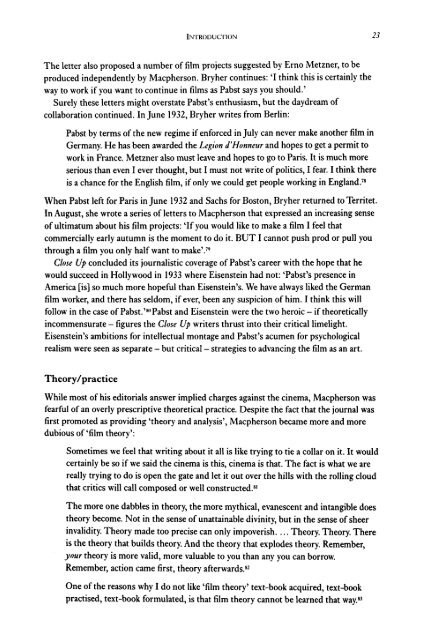close up - Monoskop
close up - Monoskop
close up - Monoskop
Create successful ePaper yourself
Turn your PDF publications into a flip-book with our unique Google optimized e-Paper software.
INTRODUCTION 7<br />
Hanns Sachs and Barbara Low debated the unconscious effects of cinematic<br />
spectatorship, and a strong contingent of female literary modernists - H.D., Dorothy<br />
Richardson, Gertrude Stein, Marianne Moore - began to write on cinema. The journal<br />
also contained a range of speculations about film technology; promoted the alternative<br />
distribution and exhibition networks of cine-clubs and film societies; addressed the<br />
problems and potentials of a British cinema; campaigned against film censorship;<br />
championed Soviet film-making and film theory; had a persistent critique of racism in the<br />
cinema; and continually assessed the state of film theory and criticism. Many of the<br />
critical and theoretical questions which troubled the contributors to Close Up between<br />
1927 and 1933 returned, as if to haunt film writers and theorists, in the 1970s and 1980s.<br />
In this regard, it is striking that the debates in Close Up were not strategically excavated;<br />
interest in alternative exhibition and distribution, political questions about<br />
representation, concerns about the economic domination of first-world national cinemas,<br />
theorizations of the role of the spectator, psychoanalytic theories of the cinematic<br />
apparatus and debates about censorship dominated the agenda of'contemporary' film<br />
theory. 'The archaeology offilm theory' - the recovery offilm theory's own history - was<br />
not a priority for film theorists of the 1970s and 1980s and would have to await the efforts<br />
of theoretically bent film historians. 17<br />
The writing in Close Up demonstrates how the cinema — grasped for its potentials,<br />
feared for its foreclosures - transformed the very fabric of psychic, gendered and<br />
racialized experience, and explored - against cinema's commercial domination — the<br />
radical possibilities of film as a new medium of aesthetic expression. Introducing the texts<br />
from Close Up now, in the late 1990s, prompts a reconsideration of a pivotal period in this<br />
century's cultural history, of the existing accounts of film history and theory and of the<br />
cinema's relation to literary and artistic modernism.<br />
Until now, Close Up has predominantly been used as source material for histories of<br />
national cinemas. Jay Leyda relied on Close Up as primary source material in his Kino: A<br />
History of the Russian and Soviet Film, as did Siegfried Kracauer in From Caligari to<br />
Hitler. Rachel Low, in her History of British Film 1918-1929, describes Close Up in<br />
more detail than any other standard film history. She assesses its historical contribution<br />
as 'very great despite its small circulation ... the Close Up writers addressed the<br />
magazine and a few books to each other and a small circle of film initiates'. 19 While Low<br />
identified many of the Close Up writers, she did not acknowledge the contribution of the<br />
poet H.D. - a writer of key importance to the journal. 20 Yet Low uses H.D.'s prose in<br />
uncredited quotations throughout the book to generalize about the style of writing in the<br />
magazine: 'the characteristic style was affected, fashionable writing in an elliptical and<br />
casual manner'. 21<br />
In 1980, Don Macpherson's collection, Traditions of Independence: British Cinema in the<br />
Thirties, productively challenged the dominant histories of the period by pointedly<br />
attacking the emphasis placed on the role of John Grierson and the GPO film unit, and<br />
reclaiming a 'forgotten tradition' in British independent film production. 22 In his essay<br />
for the volume, Deke Dusinberre describes the importance of Close Up as the 'focal point<br />
for avant-garde film activity in Britain'. 23 Traditions of Independence was intended as a<br />
historiographically rigorous counter-history, but it also inadvertently produced its own<br />
historical counter-myth. The ardent anti-censorship campaign evident in Close Up before

















